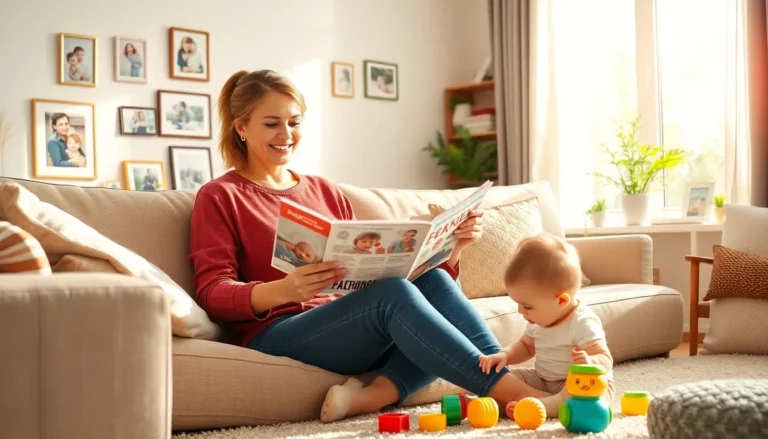Table of Contents
ToggleIn a world overwhelmed by consumerism and excess, sustainable minimalism emerges as a refreshing approach to living. It combines the principles of minimalism—focusing on what truly matters—with sustainable practices that respect the planet. This lifestyle encourages individuals to declutter not just their physical spaces but also their minds and habits, fostering a deeper connection to nature and a more intentional way of living.
Embracing sustainable minimalism means making conscious choices that benefit both personal well-being and the environment. By prioritizing quality over quantity and choosing eco-friendly products, people can reduce their carbon footprint while cultivating a simpler, more fulfilling life. As this movement gains traction, it offers a pathway to a more balanced existence, where less truly becomes more.
Understanding Sustainable Minimalism
Sustainable minimalism merges the principles of minimalism with eco-friendly practices, emphasizing a lifestyle focused on essentialism while benefiting the environment. This approach fosters a mindful way of living that prioritizes quality and sustainability.
Definition and Principles
Sustainable minimalism emphasizes living with intent by minimizing possessions and waste. Its key principles include:
- Intentionality: Making purposeful choices about what to keep or buy.
- Quality over Quantity: Investing in durable, eco-friendly products instead of numerous disposable items.
- Reduction of Waste: Decreasing consumption and reusing items, aiming for a zero-waste lifestyle where possible.
- Mindful Consumption: Evaluating the environmental impact of purchases and supporting sustainable brands.
- Connection with Nature: Fostering appreciation for the environment, promoting conservation and biodiversity.
These principles guide individuals toward a lifestyle that nurtures both personal well-being and ecological health.
The Importance of Sustainability
Sustainability plays a critical role in addressing environmental issues such as climate change, resource depletion, and pollution. Recognizing the responsibility towards the planet fosters a commitment to making better choices. Key reasons include:
- Reduced Carbon Footprint: Sustainable minimalism decreases reliance on non-renewable resources, leading to lower greenhouse gas emissions.
- Conservation of Resources: Conscious consumption conserves materials, water, and energy, promoting long-term availability.
- Promotion of Eco-friendly Practices: Supporting sustainable practices leads to greater market demand for environmentally responsible products.
- Enhanced Well-being: Adopting sustainable habits enriches overall quality of life and personal fulfillment.
- Community Impact: Engaging in sustainable practices fosters community awareness, inspiring collective action for environmental preservation.
Embracing sustainability within the framework of minimalism contributes to a healthier planet and a more meaningful existence.
Benefits of Sustainable Minimalism

Sustainable minimalism offers numerous advantages that extend beyond personal satisfaction. These benefits significantly impact the environment and an individual’s financial well-being.
Environmental Impact
Sustainable minimalism reduces waste and promotes resource conservation. By focusing on quality over quantity, consumers opt for durable products, decreasing the likelihood of disposable items contributing to landfills. For instance, choosing reusable bags over single-use plastic ones prevents plastic pollution. Additionally, conscious consumption leads to less demand for fast fashion, thereby lowering toxic waste and resource depletion. The movement also encourages individuals to support sustainable brands that prioritize eco-friendly manufacturing processes.
Financial Savings
Sustainable minimalism leads to substantial financial savings. Investing in fewer, high-quality items often results in lower overall expenses, as these products tend to last longer. For example, a high-quality pair of shoes may cost more upfront but lasts years compared to multiple cheaper pairs. Moreover, reduced consumption decreases monthly expenses related to purchasing unnecessary items. By prioritizing essential needs and embracing a minimalist lifestyle, individuals often find themselves with more savings and enhanced financial security.
Implementing Sustainable Minimalism
Implementing sustainable minimalism involves practical steps that align with eco-friendly practices and essential living. Individuals can enhance their lifestyle by focusing on mindful decluttering and choosing sustainable products.
Decluttering Mindfully
Decluttering mindfully promotes a conscious approach to simplifying one’s life. Individuals can start by assessing their possessions with intention, determining what aligns with their values and needs. Removing items that no longer serve a purpose encourages a clearer mind and enhances overall well-being. This process involves evaluating each item for its functional value, emotional significance, and environmental impact. By prioritizing quality over quantity, individuals cultivate a physical environment that reflects their commitment to sustainable living. Mindful decluttering not only minimizes waste but also fosters a deeper appreciation for the things one chooses to keep.
Choosing Sustainable Products
Choosing sustainable products is crucial for supporting a minimalist lifestyle. Individuals should seek durable items made from eco-friendly materials, such as bamboo, organic cotton, or recycled resources. Prioritizing local brands reduces the carbon footprint associated with transportation. Additionally, considering the lifecycle of products, including their manufacturing and disposal, allows consumers to make informed decisions. Emphasizing versatility in purchased items encourages long-term use, reducing the need for frequent replacements. By focusing on sustainable product choices, individuals contribute to environmental conservation while enjoying the benefits of a minimalistic approach.
Challenges of Sustainable Minimalism
Sustainable minimalism presents various challenges that individuals encounter while trying to embrace a simpler, eco-friendly lifestyle. Addressing these challenges effectively requires awareness and commitment.
Overcoming Consumerism
Overcoming consumerism remains a significant hurdle in sustainable minimalism. Society’s deep-rooted emphasis on material possessions often pressures individuals to acquire more. Recognizing the influence of advertising and social expectations plays a crucial role in combating this mindset. The following strategies help navigate consumerism:
- Awareness: Acknowledge triggers that prompt unnecessary purchases, such as peer pressure or marketing techniques.
- Mindfulness: Practice mindful spending by evaluating the necessity and long-term impact of potential purchases.
- Education: Stay informed about the benefits of sustainable living and the consequences of overconsumption on the environment.
Maintaining Commitment
Maintaining commitment to sustainable minimalism can be challenging over time. Life changes and external pressures often threaten individuals’ resolve. To ensure long-term adherence, consider these approaches:
- Goal Setting: Establish specific, achievable goals related to sustainable practices, which can provide motivation.
- Community Support: Engage with like-minded individuals through groups or online forums to share experiences and encourage accountability.
- Reflection: Regularly assess personal values and successes related to sustainable minimalism to strengthen commitment and focus.
By addressing consumerism and maintaining commitment, individuals can navigate the complexities of sustainable minimalism effectively.
Sustainable minimalism offers a transformative path toward a more intentional and eco-conscious life. By embracing this lifestyle, individuals not only declutter their physical spaces but also cultivate a deeper connection with nature. The principles of mindful consumption and prioritizing quality empower people to make choices that benefit both their well-being and the environment.
As they navigate the challenges of consumerism, the commitment to sustainable minimalism becomes a powerful tool for creating lasting change. With each conscious decision, they contribute to a healthier planet while enjoying the financial and emotional rewards of living with less. This journey toward sustainable minimalism is not just about reducing possessions; it’s about enriching lives and fostering a sustainable future for generations to come.







